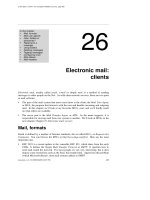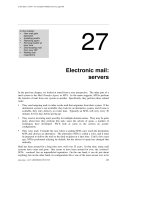Chapter 8.2 Electronic mail security
Bạn đang xem bản rút gọn của tài liệu. Xem và tải ngay bản đầy đủ của tài liệu tại đây (1023.85 KB, 20 trang )
26/11/2017
1
Lecturer: Nguyễn Thị Thanh Vân – FIT - HCMUTE
Introduction
Pretty Good Privacy
S/MIME
DomainKeys Identified Mail
2
1
26/11/2017
email is one of the most widely used and regarded
network services
currently message contents are not secure
may be inspected either in transit
or by suitably privileged users on destination system
3
confidentiality
protection from disclosure
authentication
of sender of message
message integrity
protection from modification
non-repudiation of origin
protection from denial by sender
4
2
26/11/2017
is an encryption strategy for (de)encrypting and signing
data in general and email/messages in specific.
developed by Phil Zimmermann.
provides a confidentiality and authentication service
selected best available crypto algothirms to use
integrated into a single program
on Unix, PC, Macintosh and other systems
originally free, now also have commercial versions
available
5
The actual operation of PGP consists of four services:
o Authentication: using Digital signature
• DSS/SHA or
• RSA/SHA
o Confidentiality:
•
•
•
•
CAST or
IDEA or
Three-key Triple DES with Diffie-Hellman (key exchange algorithm)
RSA
o Compression
• ZIP
o e-mail compatibility:
• Radix-64 conversion
6
3
26/11/2017
7
The digital signature service provided
by PGP
The sender creates a message.
SHA-1 is used to generate a 160-bit hash code of the message.
3. Encrypt H with RSA using PR a, and the result is prepended to the message.
4. Uses RSA with the PU a to decrypt and recover the hash code.
5. The receiver generates a new hash code for the message and compares it with
the decrypted hash code. If the two match, the message is accepted as authentic.
1.
2.
- PGP support the use of DSS signatures. It can be useful in:
-
to maintain a separate signature log of all messages sent or received;
or on an executable program to detect subsequent virus infection,
or w hen more than one party must sign a document
8
4
26/11/2017
Confidentiality is provided by encrypting messages to be transmitted
or to be stored locally as files:
1.
generates a message and a session key (random 128-bit number): one-time
key – use only once)
encrypts message using CAST-128 (or IDEA or 3DES) with session key
attaches session keyencrypted with RSA using the recipient’s public key
receiver decrypts & recovers session key
session key is used to decrypt message using RSA with its private key
2.
3.
4.
5.
Recent PGP versions also support the use of ElGamal (a Diffie-Hellman
variant) for session-key exchange
9
can use both services on same message
o the sender signs the message with its own private key, att to M
o then encrypts the message with a session key using CAST-128
(or IDEA or 3DES)
o and then encrypts the session key with the recipient's public key
using RSA (or ElGamal)
10
5
26/11/2017
11
by default, PGP compresses message after signing
so can store uncompressed message & signature
for later verification
o & because compression is non deterministic
o
signing
but PGP compresses before encrypting:
o to strengthen cryptographic security.
compress
o compressed message has less redundancy
than the original plaintext,
o cryptanalysis is more difficult
encrypting
uses ZIP compression algorithm
12
6
26/11/2017
when using PGP will have binary data to send (encrypted)
however email was designed only for text
hence PGP must encode raw binary data into printable
ASCII characters
uses radix-64 algorithm
o maps 3 bytes to 4 printable chars
o also appends a CRC
PGP also segments messages if too big
Text
ASCII
Bit 0 1 0
Index
Base
64
M
77 (0x4d)
0 1 1 0
19
T
1
0
1
22
W
a
97 (0x61)
1 0 0 0
0
1
5
F
0
1
n
110 (0x6e)
1 0 1 1
46
u
1
0
13
14
7
26/11/2017
PGP makes use of four types of keys:
o one-time session symmetric keys,
o public keys,
o private keys, and
o passphrase-based symmetric keys.
need a session key for each message, using a
symmetric encryption algorithm
o of varying sizes: 56-bit DES, 128-bit CAST or IDEA, 168-bit
Triple-DES
generated using ANSI X12.17 mode
uses random inputs taken from previous uses and from
keystroke timing of user
15
since many public/private keys may be in use, need to
identify which is actually used to encrypt session key in a
message
o could send full public-key with every message
o but this is inefficient
rather use a key identifier based on key
o is least significant 64-bits of the key
o will very likely be unique
also use key ID in signatures
16
8
26/11/2017
the message component:
includes the actual data,
filename and
o a timestamp
o
o
a signature (optional):
timestamp, encrypted SHA-1,
the Key ID
a session key component
(optional):
the session key and
the identifier of the recipient's
public key
17
each PGP user has a pair of keyrings:
public-key ring contains all the public-keys of other PGP users
known to this user, indexed by key ID
private-key ring contains the public/private key pair(s) for this
user, indexed by key ID & encrypted keyed from a hashed
passphrase
security of private keys thus depends on the passphrase security
18
9
26/11/2017
19
20
10
26/11/2017
21
rather
than relying on certificate authorities
in PGP every user is own CA
o can sign keys for users they know directly
forms a
“web of trust”
o trust keys have signed
o can trust keys others have signed if have a chain of
signatures to them
key
ring includes trust indicators
users can also revoke their keys
22
11
26/11/2017
23
e-mail format standards:
o Traditional - RFC 822: text only
o Internet Message Format - RFC 5322
o MIME (Multipurpose Internet Mail Extension) - RFC 2045-2049
o S/MIME
E-mail Format includes: header and the body.
Ex,
24
12
26/11/2017
MIME:
o an extension to the RFC 5322 framework
o solves some of the problems and limitations of the use of SMTP
• cannot transmit executable files or other binary objects
• cannot transmit text data that includes national language characters
• reject mail message over a certain size
….
The MIME specification includes the following elements.
o Five new message header fields (information about the body)
• MIME-Version, Content-Type, Content-Transfer-Encoding, Content-ID,
Content-Description.
o A number of content formats are defined
• Text, image, video….
o Transfer encodings are defined that enable the conversion of any
content format into a form that is protected from alteration by the mail
system
• 7bit, 8bit, and binary, base64
25
S/MIME:
o security enhancement to MIME email
o have S/MIME support in many mail agents
• eg MS Outlook, Mozilla, Mac Mail etc
o Provide many functions
o Use many cryptographic algorithms
26
13
26/11/2017
enveloped data
o encrypted content and associated keys
signed data
o encoded message + signed digest
clear-signed data
o cleartext message + encoded signed digest
signed & enveloped data
o nesting of signed & encrypted entities
27
digital signatures:
o DSS & RSA
hash functions:
o SHA-1 & MD5
session key encryption:
o ElGamal & RSA
message encryption:
o AES, Triple-DES, RC2/40 and others
MAC:
o HMAC with SHA-1
have process to decide which algs to use
28
14
26/11/2017
S/MIME secures a MIME entity with a signature,
encryption, or both
forming a MIME wrapped PKCS object
have a range of content-types:
enveloped data: An encrypted S/MIME entity.
signed data: A signed S/MIME entity
clear-signed data
registration request
certificate only message
29
S/MIME uses X.509 v3 certificates
managed using a hybrid of a strict X.509 CA hierarchy &
PGP’s web of trust
each client has a list of trusted CA’s certs
and own public/private key pairs & certs
certificates must be signed by trusted CA’s
30
15
26/11/2017
have several well-known CA’s
Verisign one of most widely used
Verisign issues several types of Digital IDs
increasing levels of checks & hence trust
Class
Identity Checks
Usage
1
name/email check web browsing/email
2
+ enroll/addr check email, subs, s/w validate
3
+ ID documents
e-banking/service access
31
3 proposed enhanced security services:
o signed receipts:
• to provide proof of delivery to the originator of a message
• allow s the originator to demonstrate to a third party that the recipient
received the message
o security labels:
• Is a set of security information of the content that is protected by
S/MIME encapsulation.
• may be used for access control, w hich users are permitted access
o secure mailing lists:
• The user can do not use of each recipient's public key by employing the
services of an S/MIME Mail List Agent (MLA).
• An MLA can take a single incoming message, perform recipient-specific
encryption for each recipient, and forw ard the message.
• The originator of a message need only send the message to the MLA,
w ith encryption performed using the MLA's public key
32
16
26/11/2017
33
see RFC 4684- Analysis of Threats Motivating
DomainKeys Identified Mail
describes the problem space in terms of:
o range: low end, spammers, fraudsters
o capabilities in terms of where submitted, signed, volume, routing
naming etc
o outside located attackers
34
17
26/11/2017
a specification for cryptographically signing email
messages
so signing domain claims responsibility
recipients / agents can verify signature
proposed Internet Standard RFC 4871
has been widely adopted
35
to provide an email
authentication technique
transparent to user
o MSA sign
o MDA verify
for pragmatic reasons
36
18
26/11/2017
37
2 processes:
signing Administrative Management
Domain (ADMD) is performed by an
authorized module w ithin the signing
ADMD and uses private information
o verifying ADMD is performed by an
authorized module w ithin the verifying
ADMD and uses public information from
the Key Store.
o
• If the signature passes, reputation inf ormation
is used to assess the signer and that
inf ormation is passed to the message f iltering
sy stem.
• If the signature f ails or there is no signature
using the author's domain, inf ormation about
signing practices related to the author can be
retriev ed remotely and/or locally, and that
inf ormation is passed to the message f iltering
sy stem.
38
19
26/11/2017
have considered:
o secure email
o PGP
o S/MIME
o domain-keys identified email
Practice:
o Setup 1 mail server (on linux OS)
o Configure and add some tools to prevent from spams and
establish security policies for mail server.
39
Cryptography and Network Security, Principles
and Practice, William Stallings, Prentice Hall,
Sixth Edition, 2013
o Chapter 18
o Others
40
20









